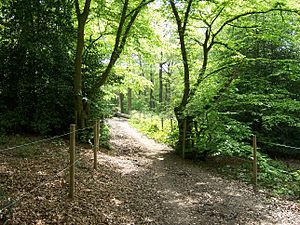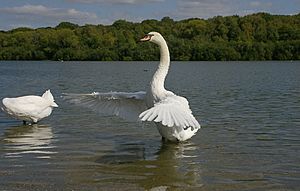Ruislip Woods facts for kids
| Site of Special Scientific Interest | |

Section of the Hillingdon Trail running through Park Wood in Harefield
|
|
| Area of Search | Greater London |
|---|---|
| Interest | Biological |
| Area | 305.4 hectares |
| Notification | 1990 |
| Location map | Magic Map |
Ruislip Woods is a very special place in Ruislip, West London. It's a huge area of woodlands, covering about 726 acres. This makes it a Site of Special Scientific Interest (SSSI) and a National Nature Reserve. It was even the second national nature reserve in an urban area of England, starting in May 1997. The woods also won the Green Flag Award in 2006, which means it's a well-managed green space.
People have lived near and used these woods for a very long time. Evidence of Bronze Age settlements, from thousands of years ago, has been found here. The strong oak trees from Ruislip Woods were even used to build famous places like the Tower of London and Windsor Castle! Locally, the Great Barn at Manor Farm was also built with wood from these very trees.
Over many years, the ownership of the woods changed hands several times. Eventually, parts of the woods were sold to the local council. The council then bought the remaining parts from other owners, bringing all the different sections together to form what we now know as Ruislip Woods.
A Journey Through Time: The History of Ruislip Woods
People have used Ruislip Woods since the Bronze Age. This was proven when a metal detector found an old spearhead in 1984. During an excavation, this spearhead, which was about 4.75 inches long, was found in a pit with pieces of pottery. This suggests it was a spot where people from an ancient settlement threw away their household waste.
These woods are what's left of the huge forests that once covered the area of Middlesex long, long ago. Over time, much of this woodland was cleared to make space for farms and homes.
After the Norman conquest of England in 1066, a man named Ernulf de Hesdin was given the manor of Ruislip, which included these woods. He then gave the manor to Bec Abbey in 1087. While the Abbey owned the woods, their timber was very important. Wood from Ruislip was used to help build the Tower of London in 1339 and Windsor Castle in 1344. It was also used for the Palace of Westminster in 1346 and a manor for Edward, the Black Prince in Kennington. Closer to home, the Great Barn at Manor Farm was built using oak trees from these very woods. Later, in 1451, King's College, Cambridge became the owners of the manor.
The area became part of the Ruislip-Northwood Urban District. At one point, there was a big plan to clear much of the woods and historic sites in Ruislip to build many new homes. This plan was approved in 1914. However, the start of the First World War stopped all construction. Only three new roads were finished before work paused until 1919.
In 1931, King's College sold parts of the woods to the local council. Park Wood was sold, and Manor Farm and the old Post Office were given as a gift to the people of Ruislip. The council agreed to look after the wood and make sure no new buildings were put up without permission.
Later, in 1936, Copse Wood and Mad Bess Wood were also bought by the councils to protect them. Mad Bess Wood is a fun name, but no one knows for sure why it's called that! One idea is that it was named after a woman who owned the land and used to patrol the woods looking for people trying to hunt illegally.
In 1984, a building called Battle of Britain House, which was in Copse Wood, was sadly destroyed by fire. This house had a secret history: during the Second World War, it was used to train secret agents for missions in France.
On May 21, 1997, Ruislip Woods officially became a National Nature Reserve. It was the first one in an urban area of England! That same year, the Ruislip Woods Trust was started. This charity works to protect the woods and help more people enjoy them.
In June 2008, a new off-road bike trail was opened in Bayhurst Wood. It's called the "David Brough Cycle Trail" and is about 2 kilometers long. It was named after a man who worked for the local council for a long time.
Amazing Nature: Plants and Animals of Ruislip Woods
Ruislip Woods is home to many different kinds of trees. You'll find strong English oak and sessile oak trees, along with hornbeam, beech, and silver birch. Other trees include wild service tree, aspen, rowan, field maple, crack willow, wild cherry, hazel, and holly.
The woods are also full of beautiful wild flowers. Look out for common knapweed, delicate harebell, and tall rosebay willowherb. You might also spot heather, pretty bluebell, woodanemone, yellow archangel, white snowdrops, and sweet-smelling honeysuckle.
Many different birds live in the woods too. The most common ones include graceful mute swans and Canada geese. You might also hear or see a robin, a green woodpecker, or a noisy jay. Other birds to spot are the nuthatch, lesser spotted woodpecker, greater spotted woodpecker, and the cuckoo. Keep an eye out for birds of prey like the sparrowhawk, and smaller birds like the tree creeper and willow tit. If you're lucky, you might even see a tawny owl or a woodcock.
To help keep the plants healthy, cattle are allowed to graze in an area called Poor's Field each year. This helps control the growth of vegetation. The woods are also home to many wild mammals. You might see foxes, hedgehogs, stoats, weasels, mink, grey squirrels, and badgers. Several types of bats also make their homes in the woods.
How Ruislip Woods is Cared For
The Ruislip Woods National Nature Reserve includes four main woodlands: Park Wood, Mad Bess Wood, Copse Wood in Ruislip, and Bayhurst Wood in Harefield. Two other areas, Poor's Field and Tartleton's Lake, are also part of the reserve.
The London Borough of Hillingdon council is in charge of managing the woods. They also run the Ruislip Woodlands Centre, which is looked after by volunteers. This centre is located near Ruislip Lido, a reservoir within Park Wood. As mentioned before, Ruislip Woods won the Green Flag Award in 2006, showing how well it's managed.
For many years, the woods were managed by a method called coppicing. This means cutting trees down to ground level every few years so new shoots can grow. The timber was then sold to local businesses. When King's College owned the manor, the woods were also used for pheasant shooting. Today, coppicing still happens, usually on a 20-year cycle. This helps the woodland grow naturally and stay healthy.
Two roads, Ducks Hill Road and Breakspear Road North, pass through different parts of the woods.




